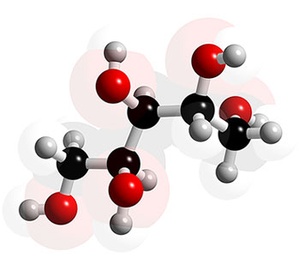 Chemical model of Xylitol Xylitol is a natural sweetener that inhibits bacterial growth.
Chemical model of Xylitol Xylitol is a natural sweetener that inhibits bacterial growth.
Chewing sugarless gum sweetened with xylitol, a natural sugar substitute is an effective way to reduce dental decay. Dental decay occurs when bacteria in the mouth break down sugars for energy and produce acids as a byproduct. These acids attack the teeth, slowly dissolving them and creating cavities. Xylitol, like other sugar substitutes, cannot be broken down by bacteria and therefore does not promote tooth decay. However, unlike other sugar substitutes, xylitol actively works to prevent decay by inhibiting bacteria growth and interfering with the bacteria’s ability to stick to teeth. Xylitol occurs naturally in many plants; it is commercially harvested from birch trees and corncobs. Xylitol is just as sweet as sugar, but has 40% fewer calories.
Xylitol is also very useful for expectant or new mothers who want to protect their children’s teeth. A 2000 study conducted at the University of Turku, Finland, showed that mothers who frequently chewed xylitol gum had children with fewer cavities. Even though the mothers had stopped regularly chewing gum when the children were age 2, at age 5 the children whose mothers chewed xylitol gum had 70% fewer cavities than those whose mothers did not consume xylitol. This was because the xylitol helped reduce the amount of bacteria in the mother’s mouths, which reduced transmission of the decay-causing bacteria to their children. Xylitol gum has also been shown to help prevent middle ear infections in children who chew it by inhibiting the growth of bacteria that cause these infections.
Xylitol can be found in many over the counter gums, mints, toothpastes, and other products. Unfortunately, not all of these products have enough xylitol to be effective. When looking for gums or mints that contain xylitol, check to see that xylitol is the main sweetener and should be listed as the first or second ingredient. This is important because quantities of xylitol less than 5 grams per day do not show a statistically significant reduction in bacteria. There also appears to be a ceiling effect for xylitol, with effectiveness leveling off at 10 grams per day. Consumption of 6 to 10 grams of xylitol divided into at least 3 consumption periods is recommended for xylitol to be effective. Most products do not print the exact xylitol content, but if xylitol is the main sweetener, it is safe to assume about 0.5-1 gram per piece. Therefore 2-3 pieces should be chewed together at least 3-4 times a day. Xylitol is not toxic, but consuming greater than 30 grams per day can have a mild laxative effect due to its slow absorption in the gastrointestinal tract. For a list of products containing xylitol visit http://www.first5oralhealth.org/library and follow the links to xylitol resources.
list of Xylitol studies related to dental decay xylitol for practiioners.pdf This is good paper about the dental benefits of xylitol
- Xylitol is toxic to dogs
- Xylitol has a cooling effect when it dissolves (endothermic)
Where to Buy in Davis
- Cost Plus World Market (soda sweetened with it)
- Davis Food Co-op (bulk xylitol)
- Kim's Mart (xylitol gum)
- epic dental gums and mints (from any Davis computer)
Products containing xylitol
- Ice Breakers Ice Cubes (contains a lot of xylitol)
- Lotte Gum (at Kim's Mart contains a lot of xylitol)
- Carefree Koolerz (discontinued)
- Altoids chewing gum (cinnamon and peppermint)
- Smint
- Starbuck's Peppermint Gum
- Spry xylitol gum
- Zellies
Pets
- Xylitol is toxic to most household critters (fatal to dogs). Be sure to keep it out of reach of your furry friends!
Comments
Chewing gum is bad for your jaw, isn't it? What alternatives do y'all recommend for people with TMJ?



